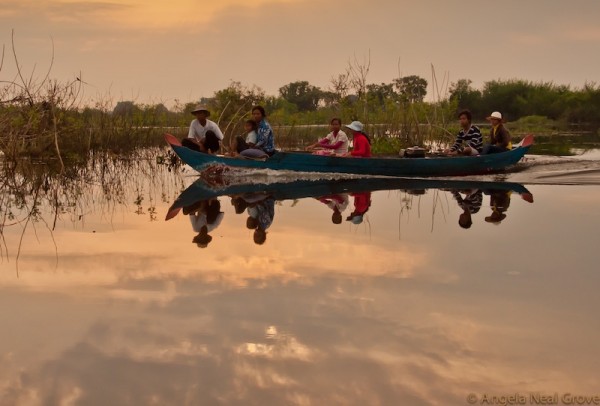 It is sunrise on Tonle Sap Lake. Reflections of mangroves are pristine in the glassy water. The sky is paling to a rosy apricot. My guide touches my arm and points to a spot-billed pelican silently cruising above us. “Just like an American plane dropping bombs on Cambodia,” he said. My heart plummeted.
It is sunrise on Tonle Sap Lake. Reflections of mangroves are pristine in the glassy water. The sky is paling to a rosy apricot. My guide touches my arm and points to a spot-billed pelican silently cruising above us. “Just like an American plane dropping bombs on Cambodia,” he said. My heart plummeted.
This was my fifth day in Cambodia. I had come to see Angkor Wat. The concept of an ancient temple unbound from the tentacles of strangler fig and tropical banyan had pulled at me like a magnet. Five days so far, each one building on the other. Layer upon layer of history. Glimpses of a glorious, glittering civilization with jewel-studded temples where princes rode caparisoned elephants across watery causeways and through towering arches. Early on the second morning we rode bicycles along the bumpy russet earthen path to the west gate of the Bayon. We had it to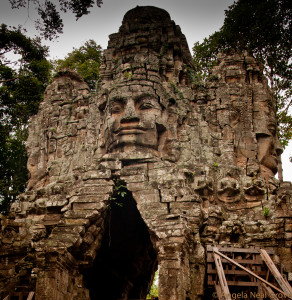 ourselves and it was magically peaceful. White trunked trees soared above us forming a natural arch. There was birdsong and frogs called from the weed choked reservoir. The Bayon’s most distinctive feature is the mass of face towers which create a stone mountain of ascending peaks. Most are carved with four faces – all different – which enigmatically stare out over the voracious jungle.
ourselves and it was magically peaceful. White trunked trees soared above us forming a natural arch. There was birdsong and frogs called from the weed choked reservoir. The Bayon’s most distinctive feature is the mass of face towers which create a stone mountain of ascending peaks. Most are carved with four faces – all different – which enigmatically stare out over the voracious jungle.
Over one million people lived around Angkor. Today the remaining 270 temples are the legacy of one of the world’s greatest civilizations which lasted for many centuries. A few are reconstructed, some partially. There are some which French archaeologists painstakingly dismantled and sorted, numbering each stone and drawing detailed maps for reconstruction. Sadly the plans were destroyed during the civil war and piles of numbered stones lie silent, their secret lost for ever.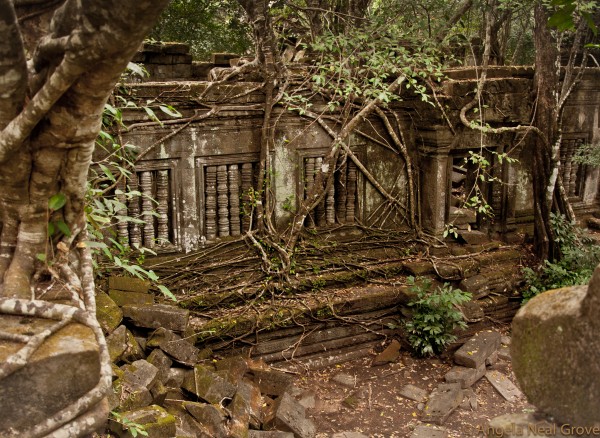
Beng Mealea, or Lotus Pond, is about 30 miles east of Angkor and built in the style of Angkor Wat. It is not restored. Tumbles of boulders encased in tapestries of green moss, and etched with lichen, bear witness to ghosts of the past. Fragments of Sanskrit and friezes of apsaras are bound by strangler fig tentacles, like a giant nightmarish squid.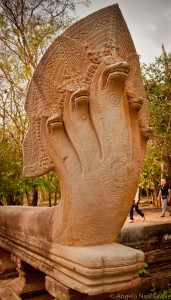 Carved heads of nagas, mythical multi headed cobras, rear up lining walkways. Walking through Beng Mealea, and clambering over the tumbled walls I felt the ghosts of the past. Talk was of the ebb and flow of civilizations. It was both heady and humbling.
Carved heads of nagas, mythical multi headed cobras, rear up lining walkways. Walking through Beng Mealea, and clambering over the tumbled walls I felt the ghosts of the past. Talk was of the ebb and flow of civilizations. It was both heady and humbling.
There were few tourists at Beng Mealea and signs indicate the area was very recently cleared of landmines. Barefoot children happily climb the rocks and trees. But to me they were unkempt, compared with children around temples in the more tourist frequented areas. There children sold souvenirs, earning pocket money to help supplement school supplies. Nothing was being sold at Beng Mealer and the children had an oddly wild look. It had been, I learned, a Khmer Rouge stronghold.
The devastation caused to Cambodia by bombing and the ensuing civil war is heart wrenching. That Cambodians are so gracious and elegant in their interactions with visitors is profoundly moving. So it was on the boat. My guide saw my confusion when he alluded to American planes and their bomb-dropping sortis. His remark took my breath away. Confused I just stood there and mumbled, “I am so sorry.” Seeing my confusion he sought to bring me back. “Ah!” he said, “but all the pelican does is drop poop!” I smiled with him and we continued with our day. The sun was rising and children in uniforms crossed the lake in flat canoes en route to school. Women were weaving water hyacinth mats and men fishing.
In a few days I would return home, but the dichotomy of the images of Cambodia on the brink of the inferno of poverty and despair, and those of its former glittering, elegant powerful civilization linger. To me Cambodia was heady, humbling and life-changing.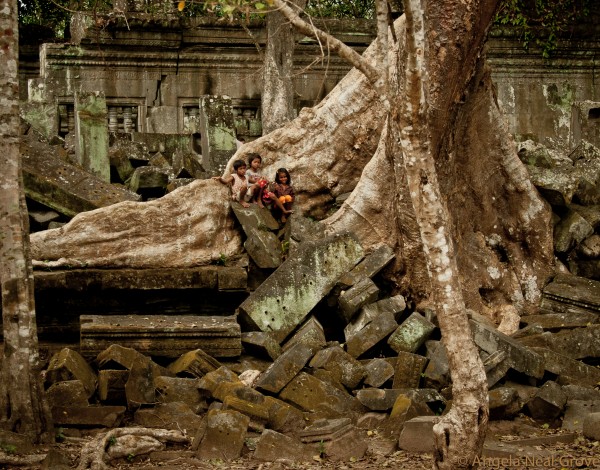
Great read fourth time or so!
Great.
Thank you